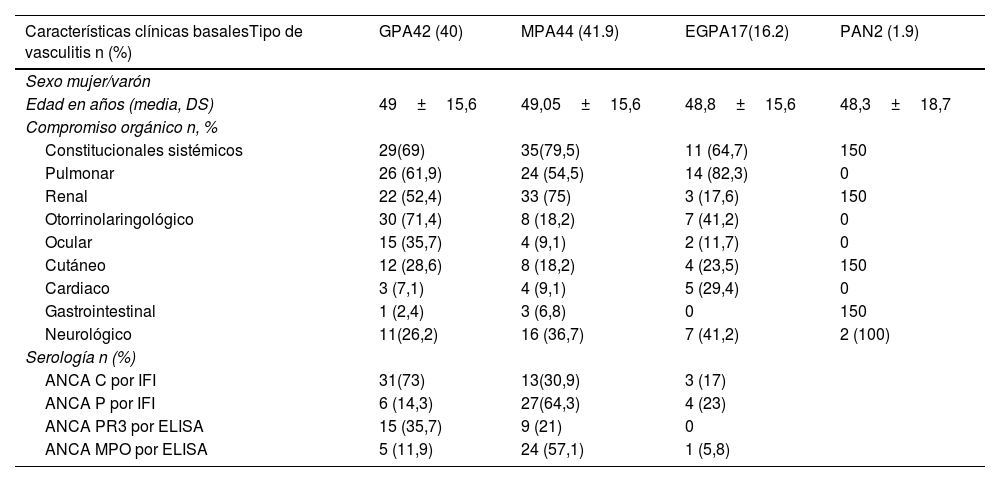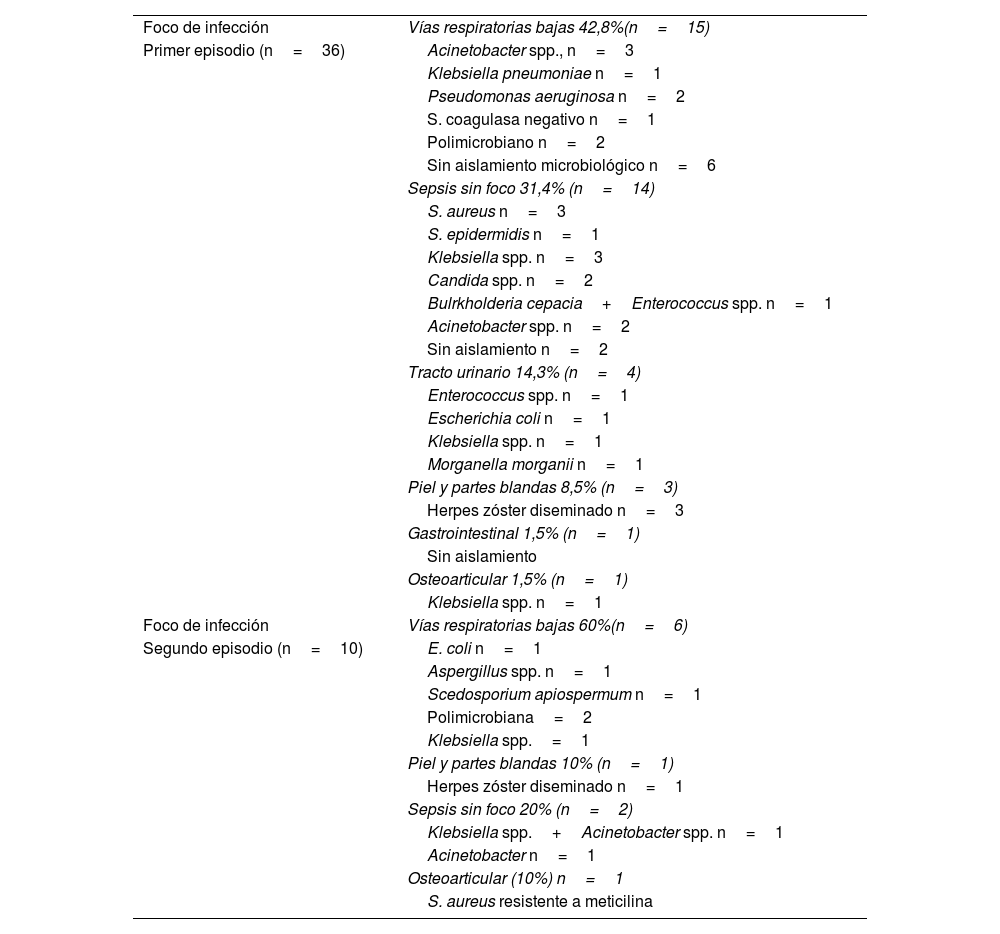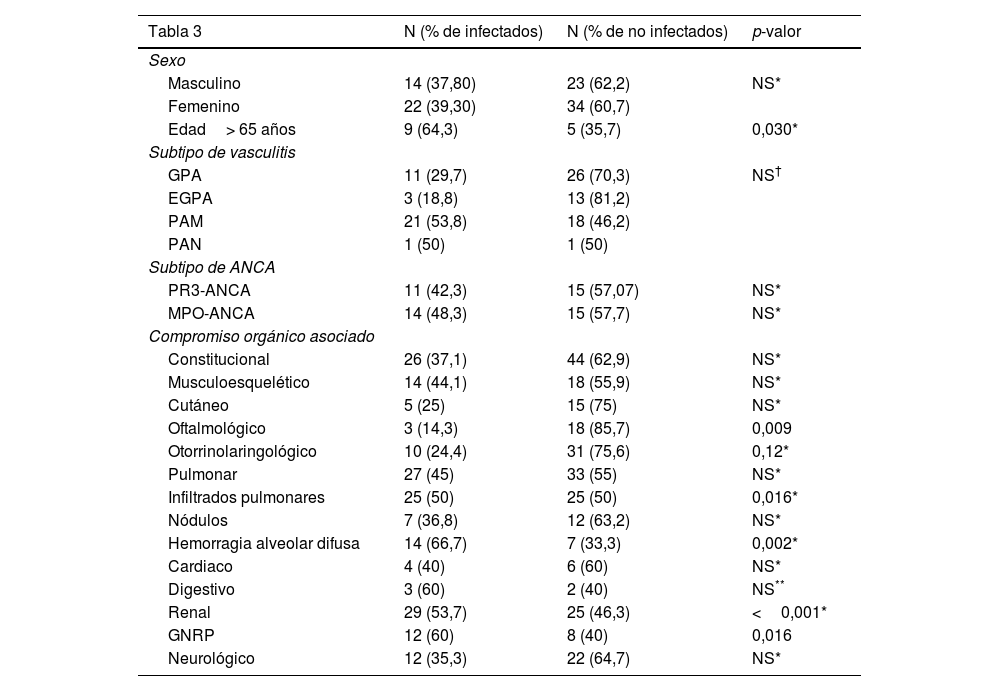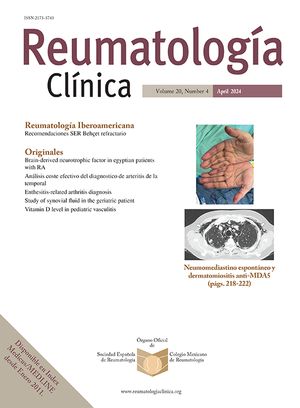Las infecciones en pacientes con vasculitis sistémica representan una de las principales causas de mortalidad. Son factores de riesgo conocidos la edad, el compromiso orgánico asociado, el uso de corticoides y de inmunosupresores, asi como el requerimiento de diálisis, entre otros.
ObjetivoDeterminar la prevalencia de infección grave y factores asociados en pacientes diagnosticados de vasculitis asociada a ANCA poliarteritis nudosa (PAN).
MétodosEstudio retrospectivo realizado en un único centro de reumatología entre los años 2000 y 2018. Se incluyó a pacientes con granulomatosis con poliangitis, granulomatosis eosinofílica con poliangitis, poliangitis microscópica y PAN. Se registraron episodios infecciosos graves que requirieron hospitalización o tratamiento antibiótico/antiviral prolongado, infección recurrente por virus del herpes zóster o infecciones oportunistas.
ResultadosSe incluyó a 105pacientes, la mediana del tiempo de seguimiento fue de 18 meses; el 58,7% eran mujeres, con una mediana de edad de 52 años; el 41,9% presentaban poliangitis microscópica, el 16,2% granulomatosis eosinofílica con poliangitis, el 40% granulomatosis con poliangitis y el 1,9% PAN. Los compromisos constitucional, pulmonar, renal y otorrinolaringológico fueron los más frecuentes.
La prevalencia de infecciónfue del 34,2% con una mediana de 3 meses desde el diagnóstico de vasculitis. Las infecciones de vías respiratorias bajas (42,8%), la sepsis (31,4%) y el tracto urinario (14,3%) fueron los sitios de infección más comunes. Predominó la etiología bacteriana (67,7%). La mortalidad en el primer episodio fue del 14,3%. Se encontraban en fase de inducción de tratamiento el 72,2%. Las infecciones se asociaron significativamente con edad >65 años (p=0,030), compromiso pulmonar (p=0,016), renal (p=0,001), BVAS3>15 y mortalidad (p=0,0002).
ConclusionesLa prevalencia de infecciones graves fue del 34,2%. Las infecciones pulmonares, septicemia y las urinarias fueron las más frecuentes y se asociaron a compromiso renal y pulmonar, así como a mortalidad, especialmente en pacientes de edad avanzada.
Infections in patients with systemic vasculitis represent one of the main causes of mortality. Corticosteroid use, immunosuppressive therapy, age, associated organic involvement and dialysis dependence are risk factors of infection.
ObjectivesTo determine the prevalence of severe infection and associated factors in patients diagnosed with ANCA-associated vasculitis and polyarteritis nodosa (PAN).
MethodsRetrospective study was conduced in a single rheumatology center (2000-2018). We included patients diagnosed with ANCA-associated vasculitis (granulomatosis with polyangiitis, eosinophilic granulomatosis with polyangiitis and microscopic polyangiitis and PAN. Serious infectious events requiring hospitalization or prolonged antibiotic/antiviral treatment, recurrent infection of herpes zoster virus or opportunistic infections were evaluated. Sites of infection, isolated microorganisms and mortality related were analyzed.
ResultsA total of 105 patients were analyzed, follow-up time median 18 months, 58.7% were women and median age was 52 years. Types of vasculitis: 41.9% microscopic polyangiitis, 16.2% eosinophilic granulomatosis with polyangiitis, 40% granulomatosis with polyangiitis, 1.9% PAN. Constitutional, pulmonary, renal and otorhinolaryngology manifestations were the most frequent.
The prevalence of infectionwas 34,2%, with a median of 3 months from diagnosis of vasculitis to the infectious event. Low respiratory tract (42.8%), sepsis (31.4%), and urinary tract (14.3%) were the most common sites of infections. Bacterial etiology was the most prevalent (67.7%). Mortality at the first event was 14.3% and a 72.2% of patients were in the induction phase of treatment.
Infectious events were significantly associated with age> 65 years (P=0.030), presence of lung (P=0.016) and renal involvement (P=0.001), BVASv3> 15 and mortality (P=0.0002).
ConclusionsThe prevalence of infection was 34.2%. Lower airway infections, septicemia and urinary tract infections were the most prevalent. Infections were associated with renal and pulmonary involvement, age older than 65 years and score BVAS>15. Severe infections were associated with mortality, especially in elderly patients.












